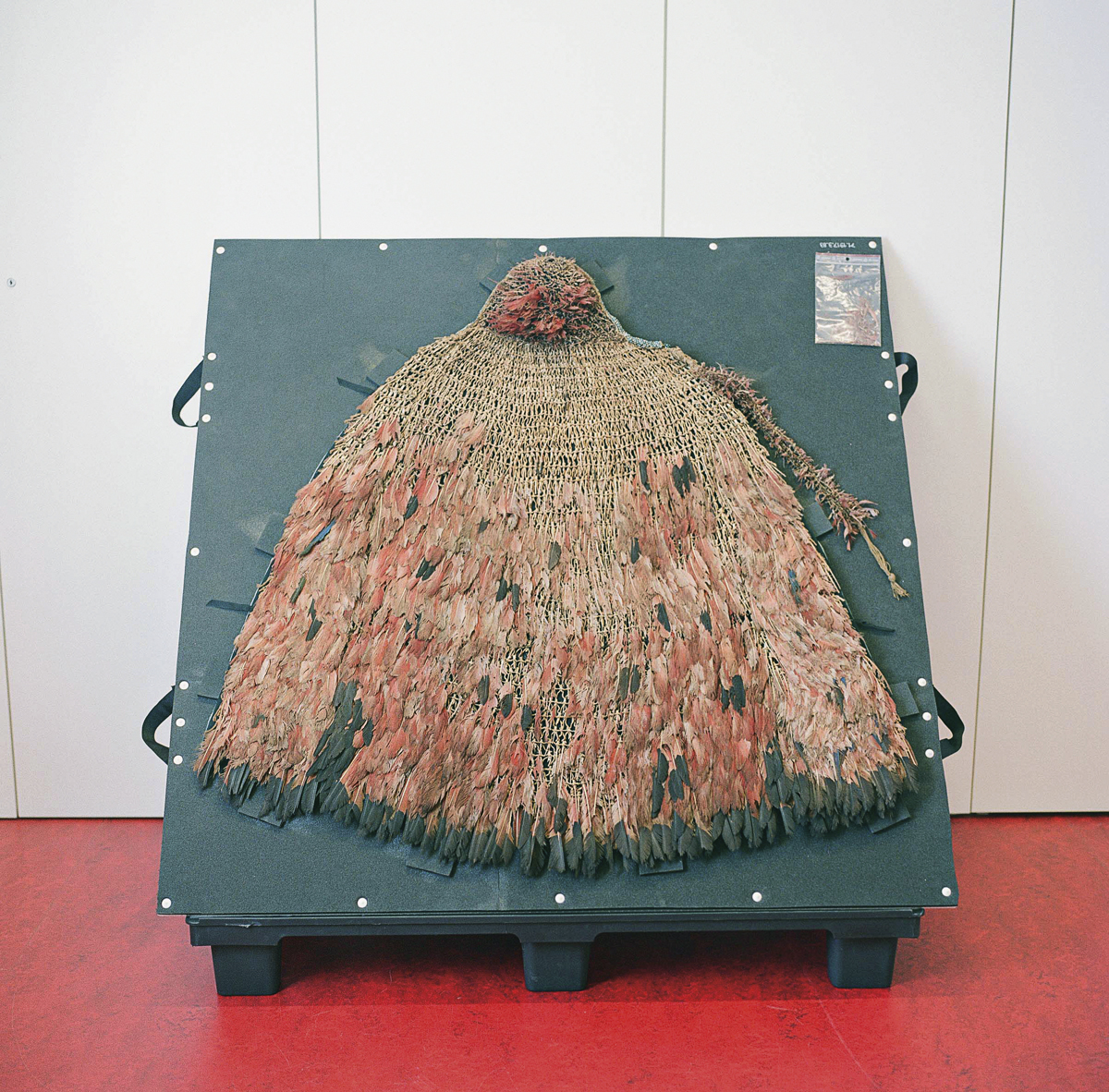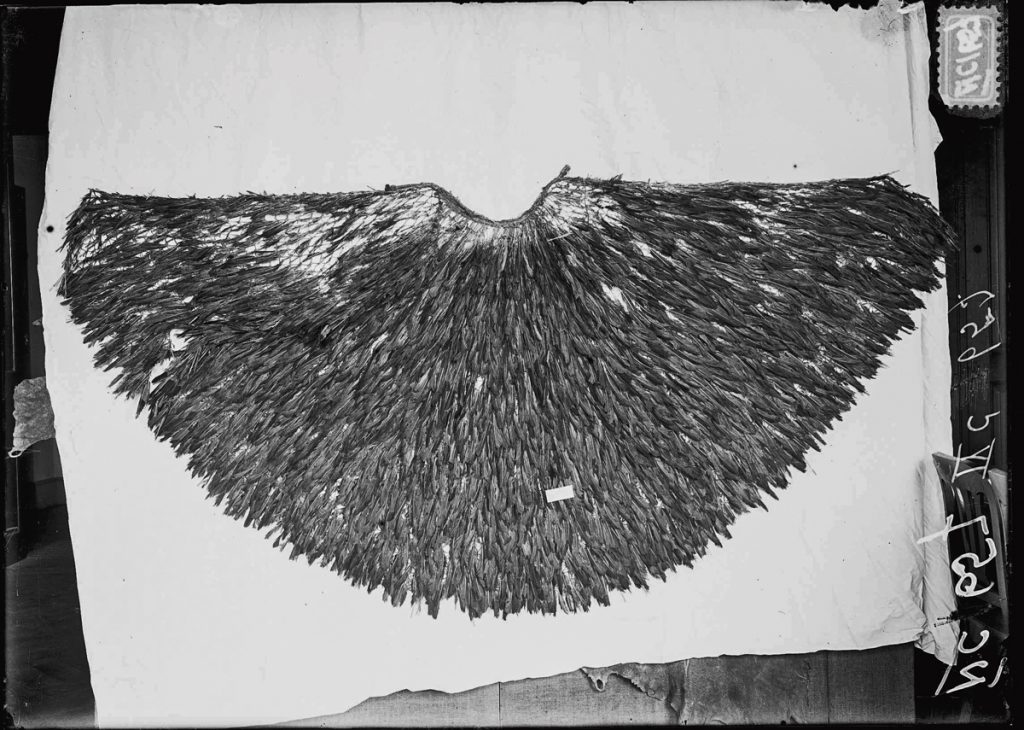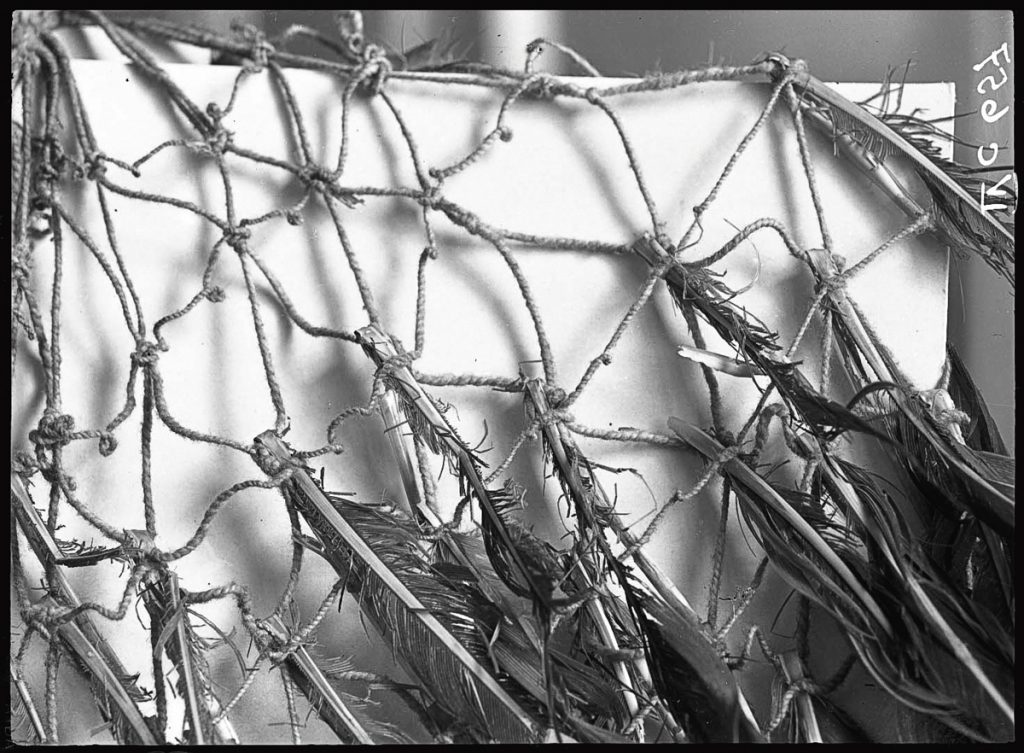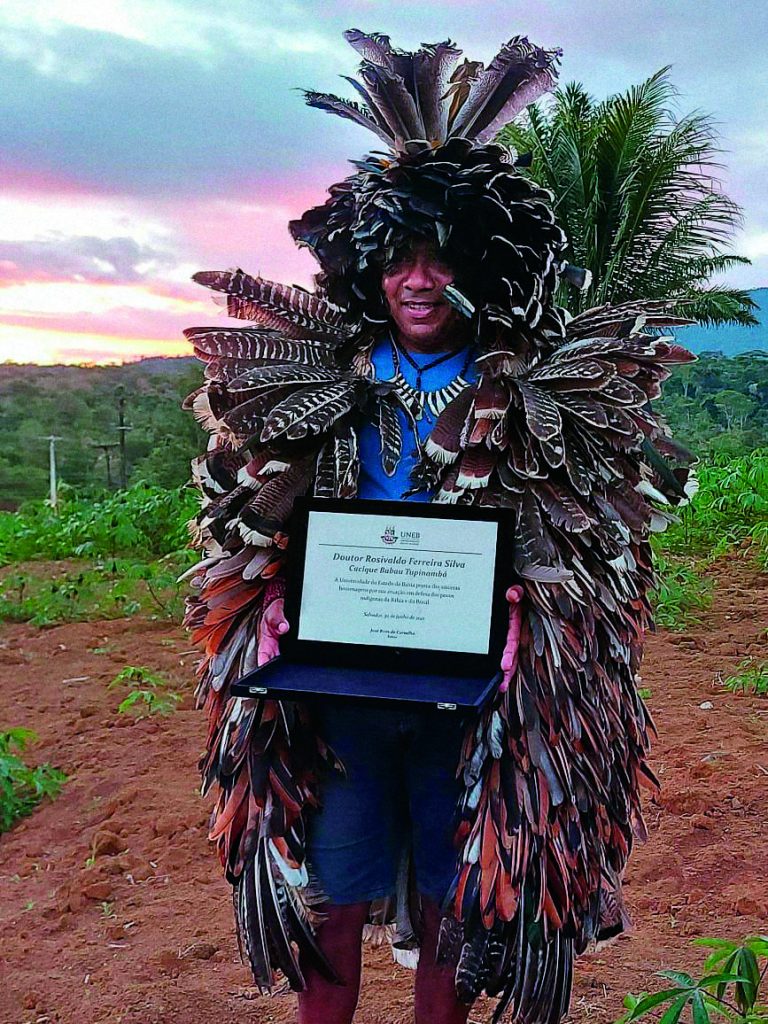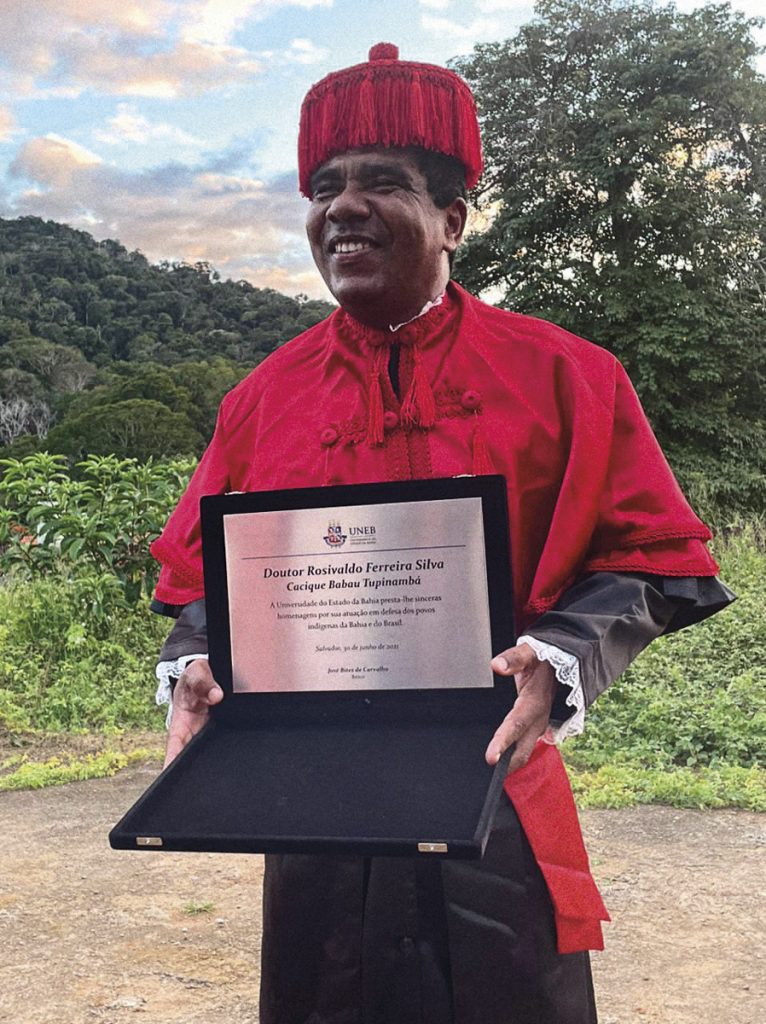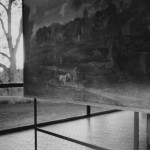The vision of the cloak
Publicado em: 7 de December de 2021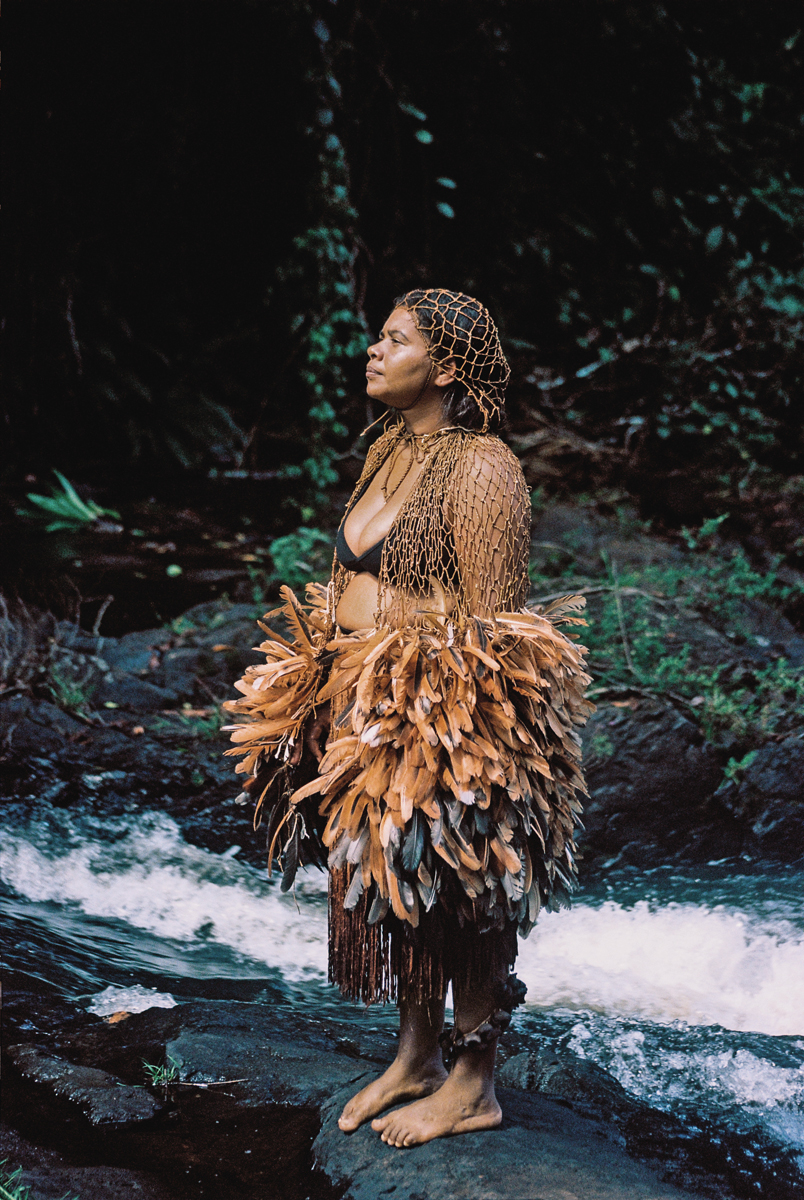
Glicéria (Célia) Tupinambá veste um dos mantos tecidos por ela, ainda inacabado, no território indígena de Olivença, em Serra do Padeiro, no sul da Bahia. Foto: Fernanda Liberti
The story of the Tupinambá cloak is marked by images. I see our culture as a pot thrown to the ground, the pieces scattered all over the place. Now we have to reassemble it as if it were a jigsaw puzzle.
The memory of the cloak is in our songs. Through them, we have succeeded in rebuilding our identity, understanding our history a little, and looking to the future. One song goes like this:
The indian* climbed the mountain entirely covered in feathers
The indian climbed the mountain entirely covered in feathers
He was, but he is
He is the king of the jurema.** Then everyone sings loudly:
The Tupinambá climbed the mountain entirely covered in feathers
The Tupinambá climbed the mountain entirely covered in feathers
He was, but he is
He is the king of the jurema.
We understand from this song that the Tupinambá man is entirely covered in feathers. But how? Only with the cloak. I began to understand that the cloak is alive in our memory. We have always heard about it. The cloak has never ceased to exist in us.
In 2000, the Tupinambá people agitated for the lands of Olivença to be recognized, which coincided with the arrival of a cloak from Denmark for the Rediscovery Exhibition in São Paulo. Dona Nivalda (her indigenous name is Amotara, the mother of Chief Valdelice), who was 67 years old, walked through the exhibition, without a guide, until she stopped before an artifact: “This is the Tupinambá cloak.” Shortly afterwards, dona Nivalda asked for the cloak to be returned to the village. This had repercussed widely. It gave visibility to our people and triggered the process to mark out the limits to our lands legally. We are still fighting for that.
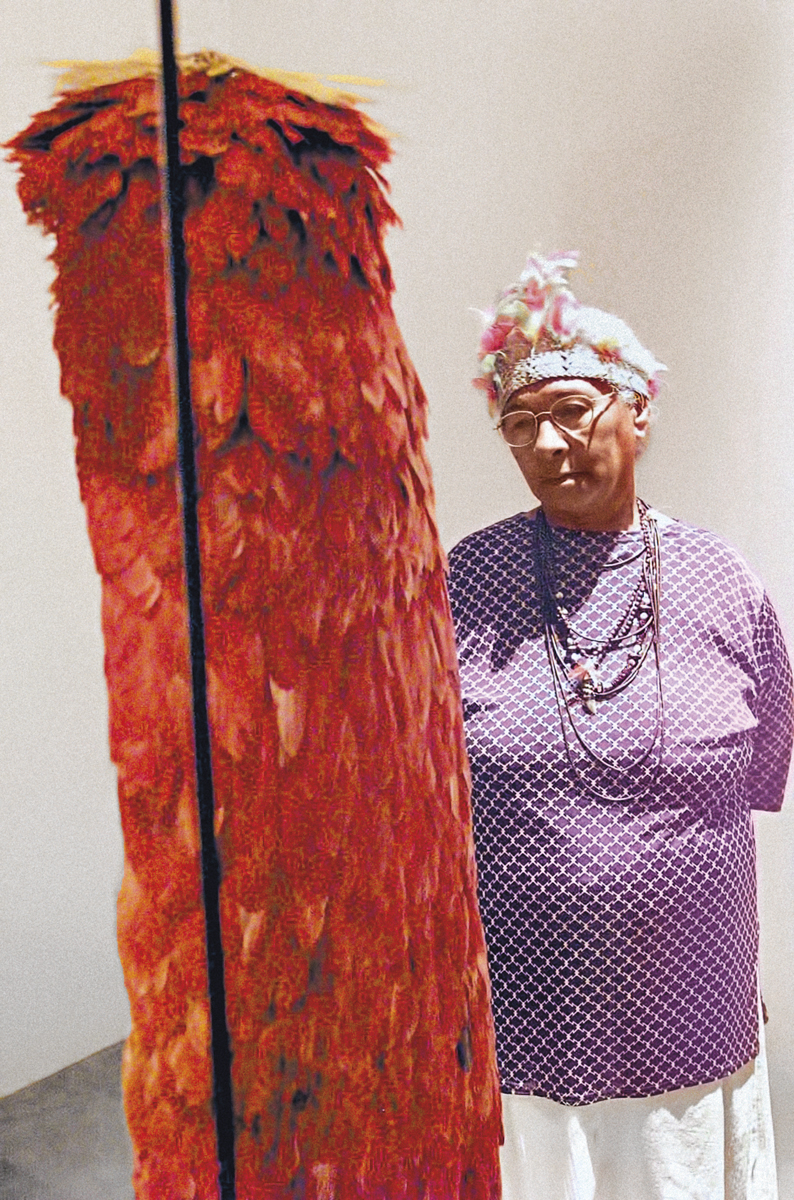
Nivalda Amaral de Jesus observa o manto tupinambá na Mostra do redescobrimento, realizada em São Paulo, em 2000. Foto: Flavio Florido/Folhapress
Every year we celebrate the Feast of São Sebastião, our religious New Year’s eve, in which the encantado [non-human beings, akin to spirits] appears and says how the sea- sons, the plantings, our lives on the land will be that year. In 2006, I decided to make the cloak to give it as gift to the Tupinambá encantados. But how? I had not seen the image yet, but I imagined it, and I had spoken to my father, who was a master of the art of weaving fishing nets, cast nets, the twine, the spindle, the shuttle and everything else. He knew how to make things, and I told him my idea. So he made the shuttle, then the twine.
At the time, professor Patrícia Navarro, from the State University of Bahia, came to the village to give talks about history and anthropology and brought along a very old overhead projector. She had some photographs of the cloak and projected them on the wall. I fell in love with that image, savouring the wonderful and beautiful object, and tried to look at the weaves. The image was really bad, but I understood the weave. So, I took some twine, took the measurements and we knocked in the nails. We started weaving, but we didn’t widen the material as we went, so it didn’t spread out as it should.

Ory veste uma carapuça feita pela mãe, Célia, a partir da fotografia de um artefato encontrado no Museu Nacional da Dinamarca. Foto: Célia Tupinambá
We went out into the yard and pursued the ducks and geese, plucking out the feathers that were mature. And we went about putting together this first cloak. The professor had explained that a cloak had about 10,000 guará [scarlet ibis] feathers, and ours didn’t have even a thousand. Since we didn’t have enough feathers, we made the cloak in the form of a cocar [headdress]. In the photo, there were some things hanging down. I counted seven pendants and applied them to the cloak. We finished it in time for the Feast of São Sebastião.
The encantado received the gift, and the celebration was really nice. Then we got an invitation from João Pacheco at the National Museum of the Federal University of Rio de Janeiro, who was organizing the exhibition The First Brazilians in Fortaleza, Ceará, in 2007. They were collecting pieces from indigenous communities and found the cloak issue interesting. The encantado allowed them to take the cloak, provided I made three more for the village. I got worried, but he said that everything has its time, that I was not to hurry.
So, the cloak went to the exhibition and the encantado left me with the mission to make three more. I didn’t know how to do it, as I would need a lot of feathers. The exhibition took place, but I didn’t manage to produce any more cloaks. I wanted to, the desire was alive within me, but I did not have the means. So, I stopped.
In 2019, a researcher from the Federal University of Bahia, Nathalie Le Bouler, invited us to give a lecture in France on the non-humans, the encantados. Jessica, my niece, was to present a work on photographs. I still didn’t know that there was a Tupinambá cloak in Europe, it didn’t occur to me, the internet here is a problem. Anyway, Nathalie told me that there was a cloak in the collection of the Quai Branly Museum and they had a borduna [stabbing spear] as well, so she requested authorization for our visit. Two Tupinambás in Europe, they had to see the cloak!
Arriving at the museum, at the door, we were searched and passed through a metal detector. We descended by elevator, passed through another door, another elevator, then someone had a look at the documents, checked in the system, we passed through another security guard and another door until we reached the object. Finally, we had arrived.
I entered a dimension in which I was in the present and in the past, I was on fire. Do you know when your hands get numb, and you feel a tingling sensation? My whole body was like that. My body was present, but my soul was absent. Nathalie was photographing me. If I closed my eyes at that moment, I saw the women sitting there, people with feathers all around them. I saw someone weaving the cloak. What most caught my attention was that they were women. I was in that place, but at the same time, in another. It was confusing. I was in a cosmic agony. My body tingled, and when I closed my eyes, I returned to that time. Three images came to me: one of the woman in the village sitting, making the cloak; another of the cloak on a ship; and a third of the cloak leaving the ship, passing over the quays and going toward an alley, and in this dark street it vanished, disappeared. I had these three images in my cosmic agony.
But I was there to see the cloak, how the feathers were fixed, the colors and the different types – of lobos-guarás [maned wolves], araras [macaws], and periquitos [parakeets]. The weave is complex, there is no way to see the main structure, it is erased. But you could make it out in the hood because it had lost more feathers there. It was possible to see that it was made of handmade cotton, and on top of it, there was another weave, which reminded me a lot of tucum [a species of Palm, Bactris setosa] twine, which is made of the thatch, with twine coming from the leaf, and not from the cotton of the fruit, which makes that wool. I realized all this information and came to notice that these materials were to be found in my community, that this twine had lasted that long because it was sealed with the wax of the jataí, tiúba, and uruçu bees [stingless South American bees].
It felt very good to be with the cloak. I stayed with it for almost an hour, and decided that when I got home, I would copy it. I left and kept trying to develop the idea.
In 2019, when it was announced that our cacique, Chief Babau, was to receive an Honorary Doctorate from the State University of Bahia for his knowledge of the indigenous peoples, they started to discuss how he should be dressed for the ceremony. Nothing would be fairer than him going dressed according to his culture. But there was the university protocol, he had to receive the degree dressed in a gown and cap, so they asked for his measurements so they could get them made. Our people kept negotiating the use of a headdress at least, but they only wanted him to be dressed in their way, nothing of our clothing, of our identity. So I said to Agnaldo Pataxó: “We let them follow their protocol and when he leaves the ceremony, we’ll make a corridor with our fellow Native Brazilians and put the cloak on him. Then we’ll see which photograph is more interesting for the newspapers – one of our Chief in a gown and cap or one of him wearing the Tupinambá cloak.” He asked for permission from the Chief, who granted it, and I got down to work.
I waxed the cord, stretched the twine, and threaded the frame, but it was already late at night, and I had to give a class. I searched for scissors to cut the twine and couldn’t find them, so I broke them all with my hand, I stretched half of them and went off to teach. My boy, Ory, who was about two or three at the time, stayed at home. He never got up to mischief or messed with things. When I arrived, I went straight to the frame and saw that there was something strange about the twines – everything was cut. When Ory woke up, I asked him who had cut the twine. “Did you find the scissors, Ory?” “I didn’t, Mummy, the scissors spoke to me, and they cut the cloak, it wasn’t me, no way, the scissors did it themselves.” I didn’t tell him off, we just had that talk.
I lay on the couch and kept thinking about it, that the scissors had spoken to him. I went there and stretched all the twine out and while I was weaving, I saw that I was wrong, because I wasn’t knotting, it was all smooth, looking like a sieve. I stopped, not thinking, without knowing where to go. I wanted to make it in the same proportions as the cloak I had seen there in the museum, I didn’t want to make it the way I had done before.
In March 2020, Professor Augustin de Tugny invited me to speak about indigenous artifacts at a seminar at the Federal University of Southern Bahia, because I had made the cloak for the exhibition The First Brazilians. Using Hans Staden’s images of the cloak, I had already recovered the enduape [thong], that pink feather of the ema [greater rhea] which would be the araçoia [petticoat] and had also managed to make the tiara. I took this material and went to the university to give the class.
When Professor Augustin began to show the images of the cloak – I did not know that there were eleven Tupinambá cloaks in Europe; the only one I knew was the one at the Quai Branly Museum –, one which most interested me was the one in Basel. It was a black-and-white photo that showed the weave in more detail because it no longer had the feathers. It allows you to see perfectly that the knotting is diamond-shaped. It was falling apart, and we suffer for that, but it was the solution to my problem! Augustin told me that researcher Lívia Melzi was taking pictures of the cloaks at all these exhibitions and museums. He showed me one that is in Germany, one in Denmark – it seems that there are five in Copenhagen. He kept showing me these beautiful cloaks. Unlike 2006, when we saw the image through the overhead projector, the images were now digital: I could zoom in and see the knotting perfectly!
When I returned to the village, I took a very large roll of twine to my godmother so she could teach me how to knot the jererê [a kind of fishing net], because I don’t even know how to crochet. She is about 90 years old and still does this it very well. I showed her the images of a princess wearing a lined cloak that Professor Augustin had left on my computer – my godmother even thought she was a saint. She looked at me and asked if I had already dreamed. “Have you already seen it?” Then she said to me: “I won’t teach you because you already know, you can go and do it!” And what now? The person who was going to teach me, take me by the hand and explain the whole process, just told me: “Go home and do it.” But as she said it, I had to believe it.
The fight for our land is difficult here, the leaders’ criminalization is huge. There was a plan to kill the cacique. During the lockdown we managed to close the BR-668 and BR-669 highways, putting health barriers in place. This helped keep the community calm. In addition, classes were suspended, and I went back to work the land with my family. Embracing being inside my community, in a quiet, calm place, was very important to making the cloak, as the environment was able to communicate with me. I knotted the net and was able to move on from that stage. The most difficult thing would be to fix the feathers. The girls had a project of raising chickens and kept giving me the feathers. Mom would pluck them and they would give them to me. As my godmother said I already knew how to make it, I decided not to try and control everything, and just followed the flow. Mom brought a bag with some 600 feathers and said they would be enough to make the cloak. I started cleaning, smoothing, and fixing them, but there were only enough for a few rows, because each row took 110 feathers. I estimated I was 3,500 feathers short.
That’s when the dreams came. One night, the cloak told me that the most difficult thing was not to find the feathers, but to finish the hood. I woke up thinking that this was something I had imagined. But the feathers kept appearing. The birds came and talked to me in my dreams, and my brother saw the feathers the gavião [a kind of hawk] had left for me on the land, there at the foot of the hills. Not to mention that the cats at home brought in a few birds, different types of bird – the canário-do-mato [flavescent warbler], the sabiá-bico-de-osso [creamy- bellied thrush]. I plucked the feathers, and they ate the birds. My little son sat near me and asked me to tell him the story of the cloak. He would take his maraca and sing to us. When he went into the yard and saw a feather, he would bring it to me. Everything was done like that in this cosmology, involving the community.
Then I had another dream: the cloak appeared and asked me how I was making it. I said that I was attaching feathers from chickens, cocks, turkeys, peacocks, arapongas [bellbirds], aracuãs [chachalacas], and kept on listing all the different types of feathers I had. And I was leaving the gavião feathers for the hood. I spoke of the virtues of the gavião, that when it flies, it glides through the air, focuses on its prey, plunges, and catches it – the gavião is amazing, that’s what attracts me to it. The cloak replied like this: “Have you stopped to think that the gavião has to land sometime? And when it lands and is surrounded, how will it get free? So, you need to attach some feathers from terrestrial birds.” It didn’t say which birds they should be, but said that they should be terrestrial, because as soon as you lose sight of them, they camouflage themselves and disappear, no one can catch them. The cloak should also have this virtue – of being able to blend into its surroundings, disappear, and not be caught.
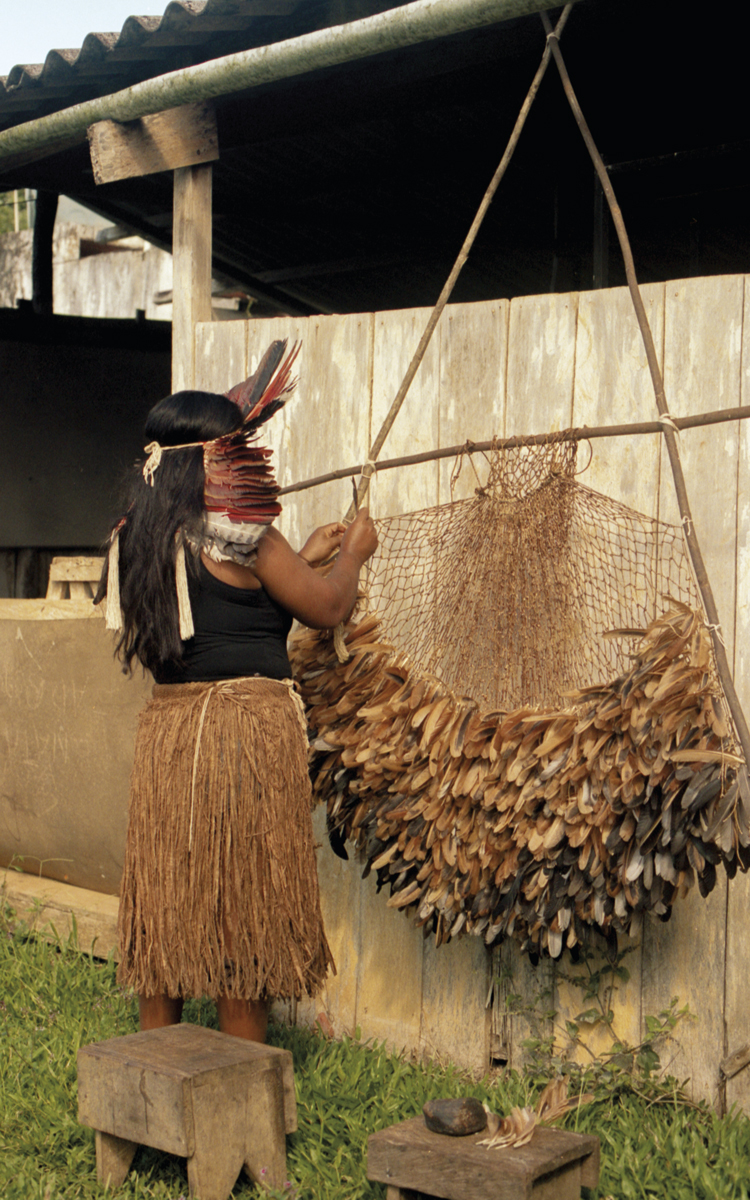
Célia Tupinambá durante a confecção do segundo manto, que viria a ser usado pelo cacique Babau. Foto: Fernanda Liberti
I woke up from this dream and went to tell Mom, because every time someone dreams, they have to go to old Maria’s kitchen to tell her about it, and the dream did not make sense to me. Mom said that the cloak was right and began to talk about birds such as the tururim [little tinamou], lambu [small-billed tinamou], quail, saracura [rail], telling me about several birds that have this ability. Chief Babau said he was going to find a little bird for me. They made a trap, caught the bird, plucked its feathers, and released it – as that’s how it should be done. In order to make the cloak, we do not have to destroy or kill, we collect the feathers when they are moulting. If they are not fully-grown, they are of no use.
Now I had the feathers, but I hadn’t a clue how to fix them, because in the hood the knotting is a little larger. I lay in my hammock thinking about it, looking at my feet. You have to have peace of mind. And guess what? My big toe could serve as measurement! I held the twine in my foot and started doing the same process that I had used to make the neckpiece. It worked!
All that lacked was the bit on top, which I call the peteca, made from the feathers of a bird’s tail. Once again, the photos… It has an image of royalty in Carnival which shows a well-spread peteca on top. It should have that effect and shouldn’t be too tight. And now? “Who taught you to make the cloak will also teach you how to finish it properly,” said Mom. I went back to sleep.
I dreamed I was lying in my hammock and along came someone, who threw a lot of jequitibá [a tree, Cariniana legalis] seeds in my face: “Look at what you are in need of.” And they taught me how it was done, how each seed should be placed in the knotting and the feathers tied on. When I woke up, I went to find Mom again, sitting by the wood-fired stove, and she told me that it made sense: “Go there, get down to business.” So I went.
A while ago, an elder named Felisberto and I had saved a jequitibá, which is at the top of hills, from the loggers. He had collected the seeds and given them to me, but I didn’t even know where they were now. In that dream, I remembered. Don’t they fit just right? The feathers had the effect I had seen in Livia’s photograph. I finished the hood, attached it to the rest, and the cloak was ready to beworn by our cacique at the graduation ceremony.
So far, from the images I know, we only see men wearing the cloaks, but I have this intuition that they have a feminine energy, that they were made by women, who could also wear them. When I dream of the cloak being returned, understanding this whole process, I see that the person here in Brazil who will be able to identify the cloak is dona Nivalda, a woman. The person who is going to try to re- produce it is me. The photos I use were taken by another woman, Lívia. With all this female energy, and these private chats and conversations I have with the cloak, I was sure that women also wore it.
My head was full of this problem when Fernanda Liberti contacted me, and the mystery was resolved: she gave me the book O Rio antes do Rio [Rio before Rio], which includes the image of a Tupinambá woman wearing the cloak on the cover! The book included three engravings dating back to 1572, made by Hans Weigel and Jost Amman: one of a man wearing the cloak; one of a woman wearing the full cloak; and the last of a man with only the neckpiece and the arupema [a kind of sieve]. Didn’t I say the cloak speaks to me? People speak a lot about the enemy, captured for the involved in the anthropophagic ritual. I do not know, because all there is the image described by the jesuits. I saw the cloak in the firelight. I imagine six women coming out from the oca [collective dwelling] covered with it to dance around the fire, not the enemy. But they had another intention. There is a Hans Staden scene where several people wearing cloaks are seen around the oca, while the women serve them cauim [manioc alcoholic drink]. This image is very beautiful, they are not dancing around an enemy. So, there are other ways, and the red and yellow were to be confused with fire, you were supposed to be a fire bird, flamed by the fire. A party, such joy.
When I open a book, my reading is different from that of other people, it seems that some words jump out at me. Like majé [female shaman]. I will read a book and this word appears, which according to the jesuits was used, but disappeared. So, I start repeating “majé”, and everyone is shocked, because they’ve never heard of it. I insist on saying that it exists and that it is women who are the mistresses of that knowledge.

Imagem de gravura feita por Hans Weigel e Jost Amman em 1572, que representa um homem e uma mulher indígenas usando o manto tupinambá. Reprodução do livro O Rio antes do Rio, de Rafael Freitas da Silva (Relicário, 2019)
From the travelers’ accounts, they only had contact with men. They had one intention, one view. They did not come to see and describe how women behaved, they only saw them as labor, in the kitchen, working, or with that sexualized look. I knew there was something else, it wasn’t just that. Then I discovered the majé, who is a kind of deity that is going to separate pairs of birds so that they can keep existing, according to the Tupinambá world view.
When I read this word, I feel that I need to repeat the name of our gods, that our pajés [male shamans] and majés are demigods and that the cloak is a personality in itself, a gift from heaven to earth, and those who wear it are in contact with both these worlds. These people, responsible for healing and guiding, were allowed to wear the cloak.
It is something that is linked to territory, to our spirituality and to the knowledge of the whole community. I have several concerns, several questions that arise and that I am trying to answer. That word “majé” has to exist. Tupinambá women wore the cloak, yes. The children could be rolled up in them because they were warm, and in winter it is very cold, and we did not go around naked, that is something from the imagination of others. We had many feathers, we were a very diverse and colorful people, and, in making the cloak, I realized that the Tupinambás reproduced the bird’s skin. You only know it by doing. We’ll go on settling our doubts with images, people send photos, videos, which are of great value to me, because each one brings a reference, a language.
We will bring another vision to the cloak, the colors of the earth, of nature, of the leaves, and it will be in the environment. We’ll put the cloak in motion, not the cloak in the color of the guará, which is over there, asleep. We will bring a living cloak, with this new clothing, invested with a political idea, a remnant of something that has not ended. It’s like sugar, which you add to water, stir and it disappears, but is still present when you drink it. The cloak has come to have that impact, it intends to resonate something else that I have yet to discover, but I know it needs to exist and echo the name of our gods.
I call this whole process of making the cloak through the photographs and dreams a “technical cosmos”. No one took me by the hand to teach me. I use a continuous twine, I do not break the twine; I do not use a shuttle, but my hands and palette to measure the size of the net mesh and to know the number of feathers. People ask me if I am the artist, and I answer that it was a collective effort, cosmological, a community thing. I was the instrument, the hands necessary for the cloak to exist again.
People go to the museum to see beauty and imagine its priceless value. The cloak there is something untouchable, just to be seen in that cold space, where it is lifeless, has no memory, is a used piece. For us, the Tupinambá, the cloak has to be in motion. It has a personality, a way to be and exist in the environment.
I wanted to see the cloak moving, so I took photos of it with the drone. We went to the river, to the forest, into the maize plantation. I tried on the cloak. I twirled, spun around. It was beautiful to see my son coming in my direction and hugging me while I wore the cloak. It produced a feeling of protection. I enjoyed learning that the photo has a role, an intention, a language – I had never thought of it in that way. I thought of recording that time and that moment, I had never thought of the intention. And the cloak tells me that it is possible to be different from that one standing there, stagnant, frozen in time, as a vision of the past that can no longer be recovered.
People always ask if I want to bring the cloak back. The people there in Denmark are so afraid of the Tupinambá because of dona Nivalda having taken that political action – asking for it to be returned. We, from Serra do Padeiro, have another vision, we understand that the encantados do not want that. If they did, everything would be easy. The encantados asked me to make the cloak and created ways and means for it to live again. The Tupinambá judged and condemned the Europeans to the maximum penalty, which is to preserve such fragile material for centuries and centuries – and they are happy to do that! The cloak shows the footprints of the places where the Tupinambá passed, and the Europeans are doomed to preserve our culture. What I think they should do is to be more open, make it easier for us to go there.

Célia e seu filho Eruthawã sob o manto tupinambá na aldeia Serra do Padeiro, Bahia. Foto: Fernanda Liberti
I want to see the cloak because I think it has something to say to me, it has something that it has absorbed, saved and is with- in it, and perhaps by getting there – it’s not certain, not something exact – it will tell me, awaken in me the same dimension I had with the first one. For the cloak came with me. It remains there but came back with me. I managed to bring it back and not just to access the beauty but re-establish the line that had been broken so long ago. There could be other people doing this.
I have been reading and I understood that our people were enslaved, we were taken from our lands, like the blacks, and taken to another continent, without being able to return to Brazil ever again. Our people have lost themselves in immensity, but the cloak has not: it is a record, it is fixed there, and they are forced to take care of it, to preserve it, spending billions. If we were to ask for the cloak back, it would be to return it to nature, not to exist anymore, because its function is to return to nature. Being there, it is a punishment, and if we bring it back, we will have forgiven them – and we have no intention of forgiving. It is only time, the time that has been established by the Tupinambá law. So, they will remain under the burden of this penalty for the rest of their lives, if that depends on the Tupinambá of Serra do Padeiro. We do not want to forgive. ///
* Translators note: the Portuguese word “índio”, in this song translated as “indian”, refers to a Native Brazilian. The original goes: “O índio subiu a serra todo coberto de pena/ O índio subiu a serra todo coberto de pena/ Ele foi, mas ele é/ É o rei da jurema.”
** A kind of tree.
CAPTIONS:
p101: Glicéria (Célia) Tupinambá wears one of the cloaks she has woven, still un- finished, in the indigenous territory of Olivença, in Serra do Padeiro, in the south of Bahia. photo by fernanda liberti
p102: Nivalda Amaral de Jesus looks at the Tupinambá cloak in the Rediscovery Exhibition shown in São Paulo (SP) in 2000. flavio florido/folhapress
p103: Ory wears a carapuça [a kind of headdress] made by his mother, Célia, from a photograph of an artifact found in the National Museum of Denmark. photo by célia tupinambá / © ethnography collection of the national museum of denmark, photo by søren greve
p104: Tupinambá cloak in the collection of the Quai Branly Museum in Paris, France. photo by lívia melzi
p106: Above, the Tupinambá cloak in the collection of the Basel Museum of Cultures, Switzerland. In the detail, the diamond-shaped stitch where the feathers are knotted onto the artifact. © basel museum of cultures/ unknown photographer
p107: Célia Tupinambá during the making of the second cloak, which was to be worn by Chief Babau. photo by fernanda liberti
p108: Chief Ba- bau dressed to receive his honorary doctorate in indigenous knowledge from the State University of Bahia, on June 30, 2021. photos by célia tu- pinambá
p109: Image of engraving by Hans Weigel and Jost Amman (1572), which represents an indigenous man and woman wearing the Tupinambá cloak. Reproduction in the book O Rio antes do Rio [Rio before Rio], by Rafael Freitas da Silva (Relicário, 2019).
p111: Célia and her son Eruthawã under the Tupinambá cloak in the village of Serra do Padeiro, Bahia. photo by fernanda liberti
Tags: antropologia visual, Descolonialismo, Museologia, Tupinambá

